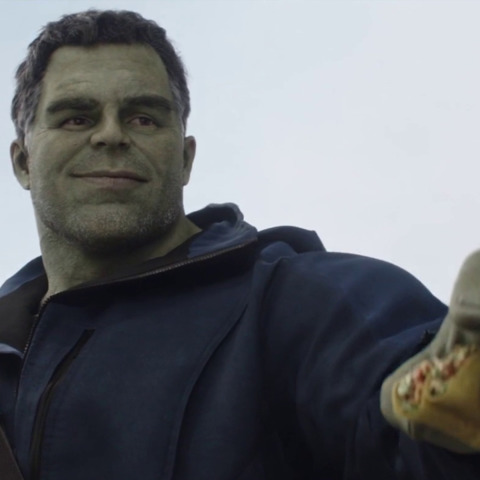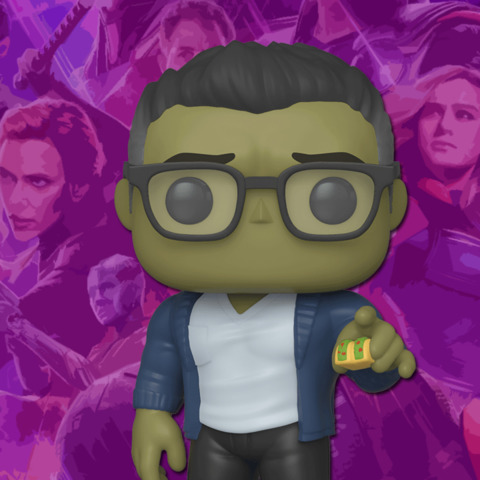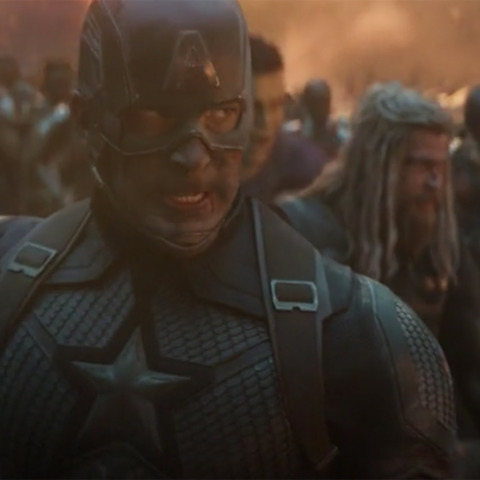Avengers: Endgame came out over the weekend, and odds are if you're as big a fan as we are, you've seen it by now. What did you think of the Avengers' ultimate battle? Let us know in the comments below. Then check out our full Endgame review, all the box office records it's breaking, every character who died or stayed dead by the movie's end, why Captain America's ending doesn't make sense, and our best guess at what that audio Easter egg after the credits was.
For all its Easter Eggs and call backs, for all it managed to do with Tony Stark, one of the most memorable and satisfying moments of Avengers: Endgame came at the hands of fan favorite character Captain America, who, just as the battle against Thanos looked its bleakest for Thor, saved the day--by wielding Thor's original hammer, Mjolnir.
Now, there are a lot of reasons that this moment is extremely cool--c'mon, it's Captain America swinging a lightning-powered warhammer around, what's not to love?--but it actually becomes even more interesting if you take a look at just what picking up a weapon like Mjolnir actually means in the context of Marvel history.
Let's break it down.
What's Mjolnir's deal? Isn't it gone?
It hasn't come up in the MCU for a while, but Mjolnir actually has an inscription. It goes like this: "Whosoever holds this hammer, if he be worthy, shall possess the power of Thor." If you think all the way back to the very first Thor movie, this part was pretty critical--Thor was stripped of his "worthiness" by Odin and cast out, leaving Mjolnir stuck in a crater on Earth with Thor unable to lift it. Of course, he eventually learned a valuable life lesson about his hubris and ego and was able to pick it up again--yay! Then, later, the "worthiness" drum was beaten again when, in Avengers: Age Of Ultron, it was played for a bit of a party trick. After the Avengers took turns trying to lift it from a coffee table, Steve was able to make it wiggle the slightest bit. At the end of the movie, it comes back as another gag with Steve, Thor, and Tony debating what would happen if you put Mjolnir in an elevator.
"Elevator's not worthy," Steve says, shaking his head.
The conversation was prompted after Vision, a synthetic humanoid built out of Ultron's AI, Tony's AI butler Jarvis, and the Mind Stone, was able to pick up Mjolnir during the final confrontation with Ultron himself. The ins and outs of Vision's whole deal vis-a-vis worthiness aren't really examined too thoroughly, but the implications are there. Not only is Vision a new, and therefore wholly "untainted" creation, he's also born of one of the universe's most powerful artifacts--a potent combination.
Since then, however, Mjolnir's symbolism and place in the MCU has shifted dramatically. With Thor: Ragnarok, we saw Hela destroy the hammer altogether, sending Thor into a crisis. Eventually, he realized that his power--his worthiness--didn't come from the hammer itself at all. "Are you Thor, god of Hammers?" Odin asked. Of course not--and we have a whole fight montage set to Led Zepplin to prove it. Later, in Infinity War, he's given a new, better weapon, an ax named Stormbreaker with no worthiness clause attached.
Here in Endgame there's a bit of an abrupt pivot. During the whole time travel adventure heist, an extremely downtrodden and depressed Thor visits the Asgard of 2013, talks with his mom before she dies, and summons the Mjolnir from 2013 into his hand. This delights him because it means, after everything, he's still "worthy," something he couldn't test with Stormbreaker.
So Mjolnir--albeit a temporally displaced Mjolnir--is back in play in time for the final fight against Thanos.
What does it mean to be "worthy?"
As far as esoteric comic book things are concerned, "worthiness" and Mjolnir is up there with the Infinity Stones in terms of being, uh, fluid to say the least. In the MCU, worthiness tends to be defined through Thor's selfishness or lack thereof--or at least by what Odin thinks is Thor's selfishness or lack thereof. After overcoming that first brush with unworthiness, Thor does just fine--even when he's behaving extremely brashly--which makes a reliable barometer for the MCU's take on the concept pretty difficult to craft.
The comics, however, have it a little bit easier. Very recently, Thor was rendered unworthy by an omnipotent Nick Fury (don't ask) who simply whispered these three words: "Gor was right." Gor, a villain known as "The God Butcher," had been one of Thor's newer enemies. He was an alien who made it his life's work to exterminate all "gods" in space. Gor's mission stemmed from his belief that all gods were petty, useless, and selfish creatures who deluded themselves into believing they were above mere mortals. During a fight, he told Thor just that: "You know I'm right. That's why you fight so hard. Why you try so desperately to seem noble."
At the time, Gor's words did nothing but make Thor more angry--and fueled him to ultimately take Gor down--but it definitely got a little under his skin. The confirmation from a man who, at the time, was literally all seeing and all knowing, was enough to completely shatter Thor's self confidence and render him unworthy of his own weapon.
So what does that tell us? There are a couple ways to slice it, but the easier of them is that worthiness directly ties into belief in one's self more than any lack of arrogance or hubris. You can be a pretty cocky guy, at the end of the day, but if you truly believe in what you're doing, and are completely free of doubt, you'll probably be worthy.
Steve's had experiences with Mjolnir in the comics as well to really drive that idea home. The most recent was actually pretty bleak and involved an incarnation of Steve who had had his backstory cosmically re-written (comics!) to be a HYDRA agent. This evil Steve was a ruthlessly loyal HYDRA zealot who was able to pick up the hammer (er, a cosmically re-written version of the hammer--again, comics) because--again--Mjolnir isn't really looking to judge whether a person's intentions are good or bad; it's only looking for absolute confidence of self.
Before that Steve (regular Steve, not cosmically re-written Steve) lifted Mjolnir (regular Mjolnir) back in the early 2011's Thor-centric Fear Itself event, and before that back in 1988 while he was taking a little break from the Captain America mantle.
So, what does that mean for that Endgame scene?
Steve tossing Mjolnir around like a champ in the final battle against Thanos is not only just a smorgasbord of fantastic visuals for any MCU fan, it's also a fun little wink to fans who have never stopped thinking about that scene in Age of Ultron. Because of the MCU's lack of clarity on Mjolnir's specific rules, it's difficult to surmise whether or not it actually says anything about Steve's character--though certainly if you prescribe the comics logic, it says he is absolutely confident that he's in the right in that moment--and who can blame him?
Sure, if you think too hard about it, it gets a bit confusing. In the comics, Mjolnir is the conduit not only for Thor's lightning and thunder powers but his entire identity, costume, speech pattern, and all. When a new worthy person picks up Mjolnir, they (sometimes) get a new costume out of the deal and a cool Olde English style accent as part of the package while Thor himself remains an Asgardian with strength and endurance but can't otherwise go around zapping people with lightning or flying. In fact, when other characters pick up Mjolnir in the comics, they typically adopt Thor's name entirely, leaving Thor to go by "Odinson" to prevent confusion.
In the MCU, however, all of Thor's abilities exist within him innately, essentially meaning there can be two Thor-powered people running around at the same time. Thor's own magic is no longer beholden to the hammer at all. It's really just a very cool weapons upgrade with an extremely high level requirement--one that Steve finally hit after around a decade's worth of work.
Does it make a ton of sense? Not really. But in the comics, a frog and a horse-monster-alien regularly toss around versions of Mjolnir like its nothing while Thor's still kicking, so we're more than happy to write them a pass on this one for the sake of an extremely cool fight scene.




